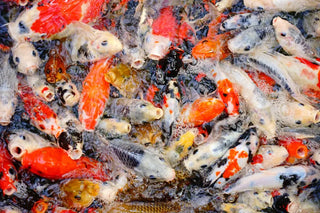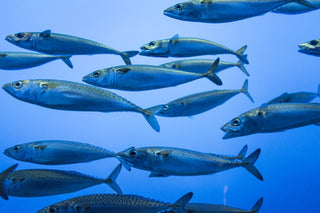
Hack Your Hormones
We Call Bull on Marine Collagen (And Cheap Bovine Collagen, For That Matter)
Collagen 101: The One In Which We Explore the provenance of bovine and marine collagen peptides
Is the romance of the sea really comparable to the grass of the Swiss Alps?
No, we’re not asking where your favourite holiday destination is, but we are asking where your collagen peptide supplements really come from and asking can you be sure they are delivering clean and efficient supplementation?
Plenty of us are convinced that taking collagen supplements might be a useful thing to do.
If you WillPowder regularly, you’ll already know that we are fans of bovine, not marine, collagen peptides. One reason for this was because bovine collagen peptides could potentially support Types I and III collagen, given that they contain the amino acids your body needs for those protein types. In your body, these two collagen types are typically co-located. It’s time to look at the finely detailed provenance of your collagen peptide choices and the potential effects those choices have on you. Yup, join us for the WillPowder’s face off between the sources and qualities of bovine and marine collagen peptides and, spoiler alert, it’s #bovineforthewin for us at WillPowders.
Reel us in! How the Idea of Marine Collagen Went From Tanks to Tummies.
Let’s start with a School of Fish wade through recent history. Some of us will be old enough to remember when our favourite department store suddenly started hosting tropical fish in enchantingly lit aquariums on the beauty concessions floor. What a crowd puller these were! We were so mesmerised with the novelty (those clever marketing people, hey?) of an aquarium plonked in the middle of the unguents that of course we needed to know why on earth there was a fish tank interrupting our seamless stroll from eye creams to eau de toilette.
No longer was it a miserable June in Melbourne or a questionable July in Queenstown as we were transported by those little fishes exploring their tank to a six foot square slice of bottomless boat ride reminiscent of warm holidays and relaxing times taking in a coral reef or two. And now it seemed the sea had something else to offer - marine extracts for our skin - how gorgeous! Suddenly, our skin care routines made us believe we were Disney’s Ariel herself. Sea algae, anyone? We started with being happy to have the natural bounty of sea plants in our face creams and from there it was only a short marketing scramble over the rockpools into slapping on the exotic novelty of marine collagen extracts. All this, even though we were hazy as to what marine collagen actually was, where it came from and how it was sourced, it sounded important and the fish were pretty and that was enough.
Those tropical tanks with their verdant hues and flashes of golden fins were a million miles away from the wet fish docks that we had seen and smelt during our childhood trips to the coast. A gnarled fisherman in his chest waders and eyebrows up to his receding hairline and a few stray scales of snapper stuck to his face just didn’t compare with the romance of cheery fish in warm turquoise tanks. And so, the allure of the marine extracts market was born, those captive fishies having worked their slippery magic on our psyche, just as they were intended to do. And so, we were (fish) hooked!
Having been convinced to slather marine plant extracts on our faces, followed by marine fish extracts, when oral marine collagen supplements arrived, it appeared just about everyone was happy to swallow what seemed in our minds to be taking the waters in a shot full of tropical oceans. To the sea! was the toast and it was ‘Bottoms up!’ from there.
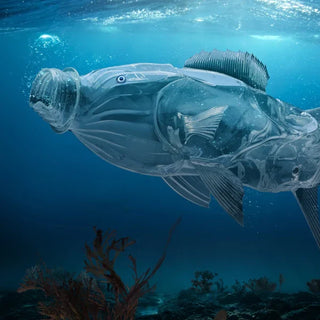

But, even the oceans are suffering a sea change
Even now, many of us are practically unaware of what marine collagen is or where its sourced. Doesn’t it come from those pretty tropical fishies, um, maybe somehow milked out of them by a mermaid at full moon? Well, in truth, no. Picture the skin of a 30 inch catch at the fish market, still sporting that one chin whisker that he forgot to pluck, and you may be closer to the truth, except now you’re not feeling quite as romanced by the seaspray. Even if you see the Marine Stewardship Council symbol on some marine collagen peptides products, the MSC label is not beyond reproach and has been accused of issuing certification with undue leniency [2].
While some marine collagen is sourced from wild caught fish, the rest coming from aquaculture, sadly, the ocean itself, rather than the sustainability of the fish is increasingly problematic in its role as the biggest fish tank in the world. Oil, plastics, microfibres, antibiotics, chemicals from the breakdown of rubbish and rubbish itself are all threatening the oceans as a habitat for marine creatures. Let’s take you through the rather depressing state of the oceans:
Oil be the Judge of that!
Unfortunately, our oceans are becoming increasingly unromantic with oil slicks, but even they don’t account for the amount of oil that has spilled into our oceans from the runoff from roads, rivers and drainpipes. In fact, there’s twice as much oil from these sources in our oceans than those oil slicks we see on the news. Nice! That’s right, used engine oil and last week’s chip fat can make its way into the sea.
Plastic not so Fantastic
We would have had to have lived on Mars for the last ten years to have avoided the messages on the increase of plastics in our oceans. But, if we are comfortably imagining that those plastics are big things that we can’t imagine fish gobbling down like plastic drinks bottles, how aware are we that those same plastics begin to break up into smaller pieces with the actions of the waves and UV light? Nemo can avoid the discarded half litre plastic bottle of water that is floating across the ocean, but he is going to struggle when those same plastic particles are only microns thick. And the other kicker is that this process releases harmful chemicals into the sea. We already know that microplastics have entered the food chains in the oceans. It makes the saying, we are what we eat, quite chilling.
The irony is that one marine collagen company within our world relies on their customers collecting the empty plastic ‘shot’ packets from their measures of marine collagen everyday, storing them up and requesting an envelope from the company that they can use to stuff as many of the plastic wraps into as possible and post them back to the company, with a sweetener that you don’t have to pay for your own postage. Why, thanks! Correct us if we are wrong, but, all the evidence points to the fact that, given our busy lives, humans usually find the quickest way from A to B, even with the best will in the world. It is a vain hope to imagine that everyone is diligently collecting those full plastic jackets and dutifully posting them back. It seems shortsighted that, if you are sourcing a product that has an investment in marine life, that you are risking adding to the problem by asking that customers put in an extra shift recycling beyond the familiar curbside or supermarket recycling. There is a huge risk that those little sachets will be sashaying towards the ocean in this convoluted process.
Marine Collagen: is it in danger of swimming in Last Season’s Fashions?
Man made fibres slough off in tiny particles when we wash our clothes and these end up in waterways and then can end up in the ocean. In fact, according to statistics from the European Parliament, half a million tonnes of the microplastics in our oceans come from the laundering of synthetic fibres every year. Whereas cotton or wool would break down because they are natural fibres, synthetics won’t do this. These microfibres have been found woven into the digestive tracts of fish. These microfibres also clog up the gills of fish and disrupt reproduction. While there is nothing to suggest that these fibres are in marine collagen, there is a question to ask about how the industry is bringing knowledge of the peril sea creatures are in and raising awareness amongst customers - asking them to consider buying natural fibres when possible or to wash clothes far less - so as to give back to the source that their product comes from.
The Ultimate Waste Disposal
In the same way that we would be askance being asked to eat something that had been feasting on the questionable bounties of the local tip, we need to consider the fact that there are five main areas of ocean that have become rubbish tips, one of which is nearly six times the size of France. If we thought that the natural salination of the oceans was enough to keep them clean, then we Little Mermaid’s need to wake up.


With WillPowders, We Like Hills That Are Alive With the Sound of Moo-sic
Compare all this to a grass pasture in Switzerland. The way cattle are farmed in the Swiss Alps is considered the most species appropriate way to rear cattle in our modern world. Unlike the burst idyllic bubble of our oceans that are struggling somewhat to provide optimum homes for the marine creatures in them, the Swiss Alps are one of the last havens of traditional - and therefore symbiotic - environments for rearing cattle. Alpine pastures provide lots of grass, herbs and wild plants that make the diet of our cattle. The cattle are free roaming which is better for their overall health and wellbeing. Even in the winter months, they are munching on the haylage from the lower pastures of the Alps which have not been grazed and so the soil is able to support the widest range of appropriate and biodiverse, nutrient rich diets. In essence, the soil has not been rinsed of vital goodies due to over farming. We think it isn’t possible to find a better place in the world to be kinder to our cows.
No vegetable or fish oils here, thank you very much!
There is no chance that our bovine beauties have anything in their diets other than grass. Side note: while this article compares the provenance of marine collagen to our Swiss Grass Fed Bovine Collagen Peptides, it is worth noting that even bovine collagen is not all equal. Some cattle are fed vegetable or fish oils. Fish oils in silage? What? When did you last see Daisy casting out on her fishing boat ready to catch fish to eat? She’s strictly vegan, for a start! We seem to live in a mixed up world in which some parts of the food industry are happy to feed foods derived from one species to another when, in nature, never the twain would meet.
One Species Versus Unspecified
There are some stories about the virtues of marine collagen that warm the very cockles (who doesn’t love a pun?) of your heart when it comes to wound healing. For example, collagen from the jellyfish, Rhopilema esculentum, might be beneficial for general use in wound clinics in the future [*]. In a world where scientists believe we all emerged from that dot of infinite mass in which every particle was touching the rest before they all burst out in the Big Bang, it stands to reason that the answers to everything could already be waiting to be combined in what exists in the universe right now and, accordingly, a particular genus of jellyfish appears to have the perfect combination of collagen to heal human injuries such as burns or wounds that might otherwise require extensive skin grafts. Fantastic!
However, it is a billion to one shot (and the rest) that the oral marine collagen peptides you might choose to ingest have come from that one genus of jellyfish. This is not how marine collagen supplements come to pass. When the manufacturers of marine collagen list FISH and SHELLFISH as allergens in marine collagen, we start to understand how generic the production of marine collagen might be.
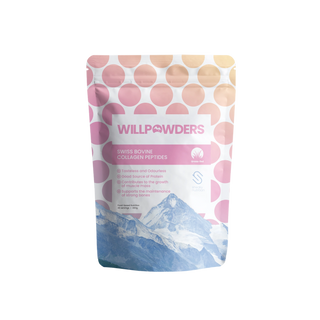

Whereas, with our hydrolysed bovine collagen peptides, there’s one common genus - cattle.
No need to ask if it’s wild-caught salmon, undersized, non-specific fish (poor tiddlers!) too small to be classed as human food but not thrown back into the oceans to keep the stocks up. And our bovine beauties eat grass and plants from Swiss pasture. Who can possibly keep track of what the molluscs, sponges, fish, jellyfish and crustaceans have been brunching on? But what we can know is about the problems the oceans are facing.
Bare Naked Hide Skin
And we don’t beat around the bush when it comes to what bit of the cattle is bringing you the collagen - it’s their hides and just their hides. Whereas, the marine collagen industry can skirt around what is in marine collagen by calling fish skins and fishbones ‘raw material’ because it suddenly seems less palatable to the many if we are asked to think about fish chum. While ‘fish collagens’ will just contain fish collagen peptides, ‘marine collagen’ might well contain a collection of fish and shellfish. No offence to a crab in the slightest, but he’s not likely to be listed as an individual ingredient, rather the star(fish) billing will more likely gloss over the fact that there could be a mele of marine creatures offering their natural collagen up for the product. If you’ve got a shellfish allergy, buyer beware! If you’re avoiding those ‘bottom feeders’, like prawns, in your diet and taking marine collagen peptides, how sure are you that bottom feeders are truly banished from your diet?
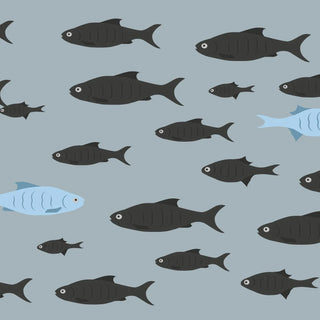

Is This a Game of Spin the Wheel?
Since marine collagen peptides come from a variety of marine sources, you might not be getting a consistent product every time. Who wants to buy a product where you’re playing a game of spin the wheel around whether this month’s supply of peptides is as consistent or inconsistent as last month's in terms of what sea creatures were transformed to be packaged in there? Bovine Collagen Peptides - consistent provenance month in, month out? Tick. Marine Collagen Peptides - consistent provenance? What does their industry say?
But, more alarmingly, little is understood about the amounts of a neurotoxin called BMAA (β-N-methylamino-l-alanine) in aquatic ecosystems. This neurotoxin has been linked to degenerative diseases of the brain.
While cattle farming learned its lesson and cleaned up its act with BSE, the Swiss cattle farmers seemingly being way ahead of that particular curve (see further reading), there is a question that needs scientists to answer it regarding the possible threat of natural aquatic systems inadvertently harbouring trouble in the form of the neurotoxin BMAA (see further reading).
Further Reading and Research
Table showing Where the industry sources marine collagen as a whole
2. Objections to the MSC issuing certifications can be found here Claire Christian, David Ainley, Megan Bailey, Paul Dayton, John Hocevar, Michael LeVine, Jordan Nikoloyuk, Claire Nouvian, Enriqueta Velarde, Rodolfo Werner, Jennifer Jacquet, A review of formal objections to Marine Stewardship Council fisheries certifications, Biological Conservation, Volume 161, 2013, Pages 10-17, ISSN 0006-3207, https://doi.org/10.1016/j.biocon.2013.01.002.
To read more about issues of our modern oceans click here
For further reading on the impact of synthetic fibres in our oceans try The impact of textile production and waste on the environment from the European Parliament
For another perspective on clothing microfibres and marine life try The Guardian Article How Your Clothes Are Poisoning Our Oceans and Food Supply
Let the Swiss Farmers tell you why their products fall under some of the most stringent rules in the world on animal welfare Swiss Farmers for You
The potential risks and the current unknowns on BMAA in aquatic ecosystems is studied in this article Presence of the Neurotoxin BMAA in Aquatic Ecosystems: What Do We Really Know? Elisabeth J. Faassen
Further Product Information
Hydrolysed Bovine Collagen Peptides
Use daily. Add to any hot or cold liquid or baked goods. Suggested daily consumption 1-15g. If you are pregnant, breastfeeding or taking medication, please consult a health practitioner. Not suitable for children under 5. Not suitable for vegetarians or vegans.
Disclaimer
Our blogs are written with love in the hope that they go some way in helping you feel like the rockstar you are, and whilst we do our due diligence, research like maniacs and fact check our stuff, we know everyone’s journey is different. They are intended to educate and empower you, not usurp medical advice. We would never advise you to stop, adjust, or modify any prescription medication without the direct supervision of your healthcare practitioner, but don’t be afraid to talk to your doctor about your new found knowledge, brought to you by the marvels of nature because they don't know everything! Blogs are always informed by Davinia but often written by a member of the team. Not all blogs reflect Davinia's experiences and sometimes provide alternative perspectives
 Collagen
Collagen
 Protein
Protein
 MCT
MCT
 Electrolytes
Electrolytes
 Vitamins & Minerals
Vitamins & Minerals
 Nootropics
Nootropics
 Accessories
Accessories
 Books
Books







